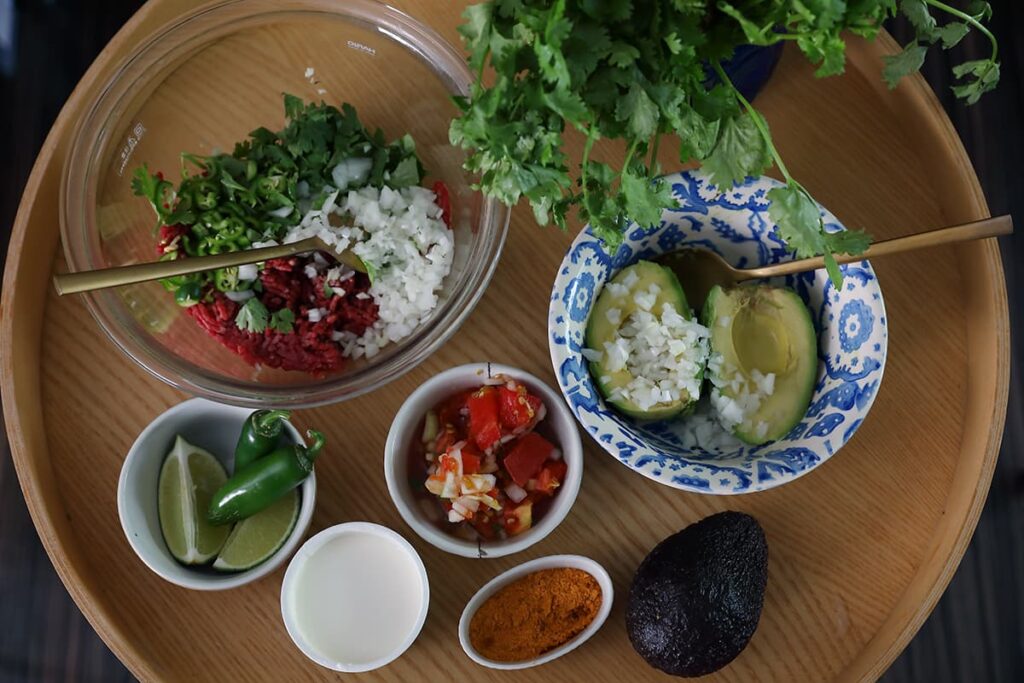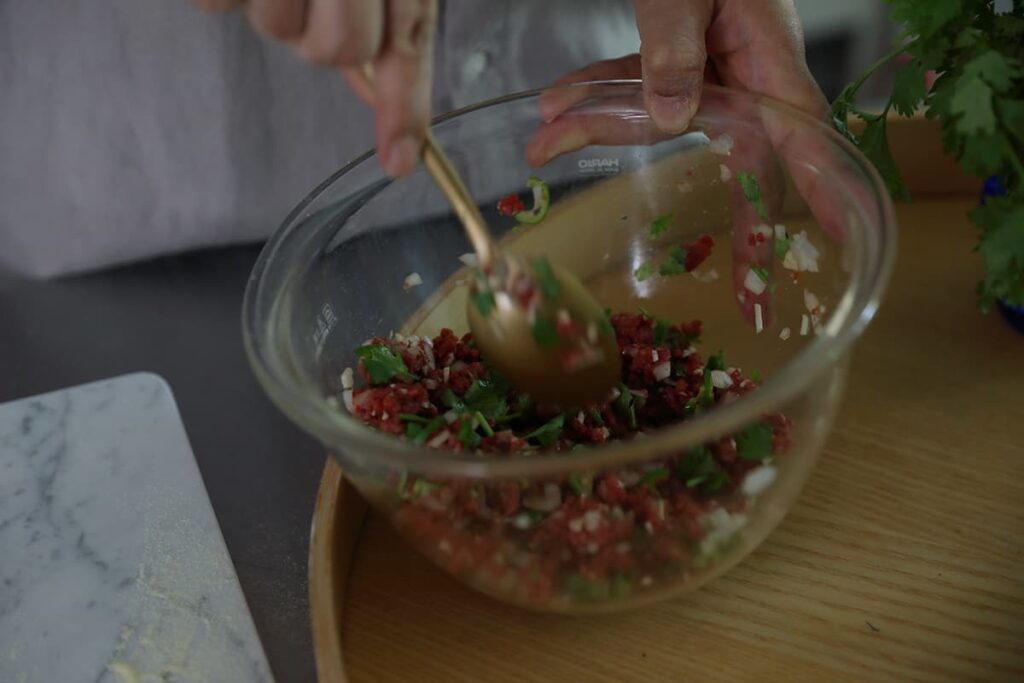メキシコ編
dumplings|2024.08.25

「旅する餃子」第6回目はメキシコ編。
メキシコといえばタコスやワカモレ、ハラペーニョ。そしてモヒートやテキーラといったパンチの効いたお酒たち。なにかと刺激的なこの国に、餃子があったらどんな味?


死者も来世を楽しんでいる、それがメキシコ流。
真夏になると俄然、飲みたくなるのがモヒート。最高気温35度くらいの日の夕方に、マリアッチを聴きながら、きんきんに冷えた一杯を飲む至福。ミントの香り、ラムの旨味、ちょっぴり砂糖の甘味を炭酸でスキッと楽しめば、気分はすっかりメキシカン。ところでメキシコといえば麻薬カルテルのイメージがあり、ちょっと不穏な匂いがする。先日も、シナロア・カルテルのトップの息子が捕まったとニュースでやっていた。そんなメキシコには、ガイコツの置物がたくさんあり、やっぱり不穏。メキシコでガイコツはカラベラと呼ばれていて、11月に盛大に祝われる死者の日に飾られる。そんなカラベラは人形や飾り物にぴったりで、レストランの装飾や観光地の土産物として増産された。そしていまではすっかり、メキシコを代表するキャラクターのようになっている。亡くなった人が帰ってくるという、日本のお盆のようなメキシコの死者の日。この日に飾られるカラベラは、悲しみではなく喜びの象徴。亡くなった人たちが来世で幸せに暮らしていることを表現しているという。だからギターを弾いていたり、歌っていたり、躍っていたりで、どのカラベラも楽しそう。不穏な匂いもどこ吹く風、辛さも苦しみも、その影を引きずりながらも陽気に消化していくのがメキシコ流。そんなメキシコにもし餃子があったら。空想する料理家、松井のアイデアが湧きだして、さてさて、どんな味に仕上がったのか?
The dead enjoy the afterlife—that’s the Mexican way.
In the height of summer, nothing beats an ice-cold mojito. On a 35-degree Celsius evening, enjoy the mint aroma, rum flavor, and soda’s sweet fizz while listening to mariachi music, and you’ll feel completely Mexican.
Speaking of Mexico, it’s also associated with drug cartels, giving it an ominous reputation. Recently, the son of the Sinaloa Cartel leader was captured. In this context, the many skeleton figurines in Mexico also feel a bit ominous.
In Mexico, skeletons called “calaveras” are displayed during the Day of the Dead in November. These calaveras, perfect as dolls and ornaments, are mass-produced as restaurant decorations and tourist souvenirs, and are representative characters of Mexico.
The Day of the Dead in Mexico, like Japan’s Obon, is when deceased loved ones return. Calaveras displayed on this day symbolize joy, representing the deceased happily living in the afterlife. That’s why they look like they’re having fun, playing guitars, singing, or dancing.
The ominous feel dissipates as Mexicans cheerfully process pain and suffering with light-heartedness. What if such a Mexico had dumplings? Chef Matsui’s culinary imagination takes flight, making us wonder what flavors she will create.


暑い日に手づかみで楽しみたい餃子が完成。
メキシコに餃子があったら?松井はまず、南米でよく食べられているエンパナーダとメキシコの名物料理であるタコスをイメージ。エンパナーダとは小麦粉をベースにしたミートパイのようなもので、南米全土で愛されている郷土料理。タコスはみなさんもご存知の、あのタコス。では、松井のレシピを紹介しよう。まず皮は、トルティーヤでよく使われるコーングリッツをベースに小麦粉を混ぜて軽く仕上げた。トルティーヤとはメキシコの伝統的な薄焼きパンのこと。餡には牛肉と玉ねぎ、コリアンダー、生のハラペーニョとタコスのシーズニングを少々。ここでメキシコらしさを演出しているのは、やはりハラペーニョ。あのじんわりくる辛さはクセになる。さらに、メキシコのタコスは基本的には揚げられていないのだが、ここは敢えて餃子を揚げることで、夏っぽいジャンクが味わえることを松井は狙っている。さらに、付け合わせにはワカモレとサルサソースにサワークリームを用意。こちらもメキシカンスタイルだ。“Buen provecho!” 餃子のような、タコスのような、でもカリッと揚がっていて、冷たくまったりとした付け合わせとよく合う。そしてハラペーニョの辛さがいいアクセントになっている。手でつかんで、ワイルドに食べたくなる美味しさ。この餃子もやはり、35度くらいの暑い日の夕方に、きんきんに冷えたモヒートと一緒に楽しみたい。
Dumplings as the perfect finger food on a hot day.
What if Mexico had dumplings? Matsui first envisioned the South American empanada and the famous Mexican dish, tacos. Empanadas, meat pies made with a wheat flour base, are beloved throughout South America. Tacos are the dish we all know and love.
Let’s introduce Matsui’s recipe. For the wrapper, she used a blend of corn grits, commonly used in tortillas (a traditional Mexican flatbread), and wheat flour for a light finish. The filling includes beef, onions, coriander, fresh jalapeño, and a bit of taco seasoning. The jalapeño gives a Mexican flair with its addictive slow-burning spiciness. While Mexican tacos are typically not fried, Matsui chose to fry the dumplings for a summer junk food vibe.
For sides, she prepared guacamole, salsa, and sour cream, sticking to the Mexican style. “Buen provecho!”
The dumplings, crispy and fried, pair well with the cold, creamy sides. The jalapeño spiciness adds a nice kick. Perfect for hot summer nights, these dumplings are best eaten with your hands and paired with an ice-cold mojito.

《料理家》 松井まり子 Mariko Matsui
株式会社De-De
Senior Art Director/Graphic Designer/Food Stylist
アートディレクター、フードスタイリストとして活動する傍ら2024年にはDe-De GYOZAもスタート。




